Analytical Predictor-Corrector Guidance Algorithm Based on Drag Modulation Flight Control System for Mars Aerocapture
Abstract
Aerocapture is one of the essential technologies for future large-scale space exploration missions, as it can significantly reduce the Δv and fuel requirement. The performance and robustness of two different aerocapture control methods are analyzed around Mars exploration, and then an analytic predictor-corrector guidance algorithm for drag modulation flight control system is proposed. A piecewise linear function between velocity and flight path angle is established by appropriate approximations and assumptions, and then the state at atmosphere interface can be predicted by an analytical method; therefore, aerocapture guidance can be realized by feedback control. Numerical simulation is used to evaluate performance and robustness of the algorithm. The simulation results show that the guidance algorithm is accurate and robust, which can effectively overcome the influence of atmospheric density error, aerodynamic parameter error, and initial state uncertainty.
1. Introduction
For a planetary orbital mission, the probe must implement a series of maneuvers to ensure that the probe is captured and becomes an orbiter when arriving at the target. The requirement of velocity reduction has been an important constraint, and the probe must carry so much propellant that limits the dry weight of it. Therefore, it is one of the problems on how to save the propellant and enter the target orbit quickly and accurately. Aerocapture is an effective way to solve the problem above [1–3]. The fundamental principle of aerocapture is to reduce the velocity by utilizing the aerodynamic drag effectively when crossing the planet’s atmosphere, and only a small amount of propellant is needed for achieving the target orbit. As shown in Figure 1, the probe enters the atmosphere along the hyperbolic orbit and then slows down thanks to aerobraking. If the velocity decrement is appropriate, the probe will fly out of the atmosphere and be an orbiter, but when the perigee is still below the atmosphere at the moment, a correction maneuver must be carried out to raise the perigee when arriving at the apogee. The precise control of the velocity decrement is crucial for aerocapture.
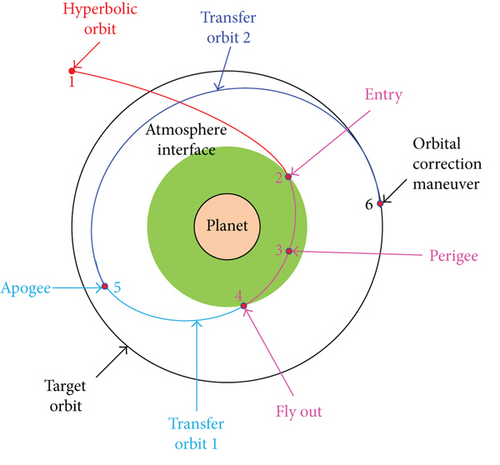
Guidance is one of the significant factors in achieving aerocapture. The guidance algorithm of aerocapture is related to the control variables. In general, the state variables that can be adjusted include lift and drag; correspondingly, there are two kinds control modes: lift modulation mode and drag modulation mode. The first one is to correct the flight trajectory by adjusting the lift direction. In this way, the probe must be able to generate a lift during flight; it is generally using a centroid offset blunt-cone configuration like Mars Science Laboratory [4], as shown in Figure 2. Here, the bank angle is defined as the angle of rotation around the velocity vector.


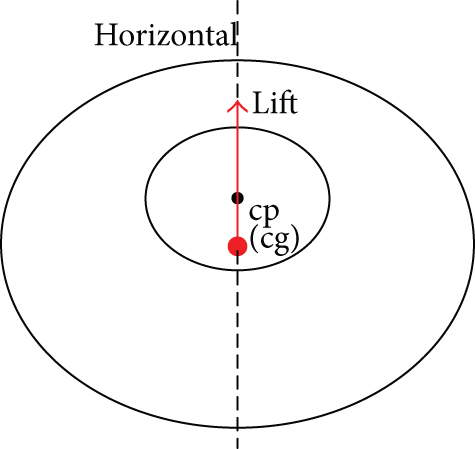
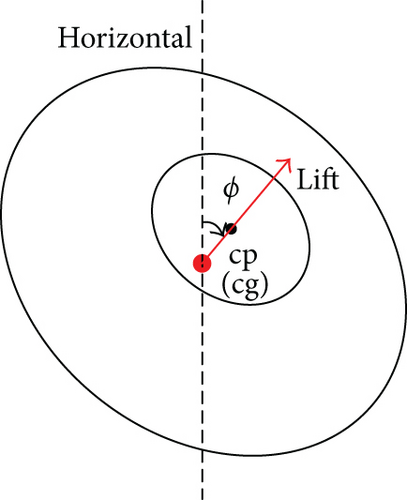
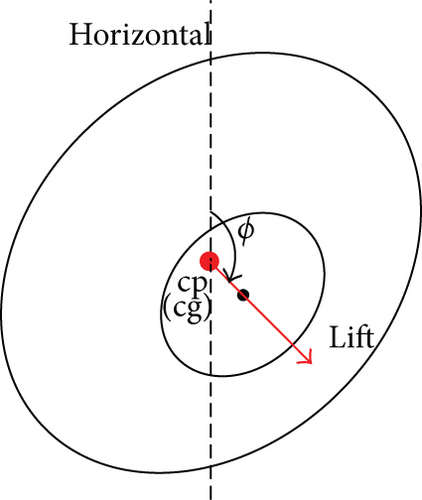
Another way is to adjust the drag by changing the reference area of the probe, such as hypersonic inflatable aerodynamic devices (HIADs) [5–8]. In order to control the velocity decrement, the probe may need to increase or decrease the reference area when captured trajectory deviates from a predetermined trajectory [9], as shown in Figure 3.
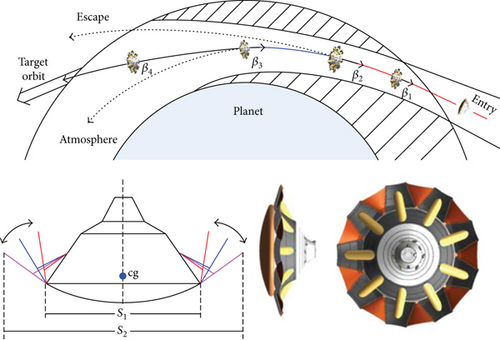
Up to now, a variety of aerocapture guidance algorithms has been developed for the lift modulation flight control system, such as the analytical predictor-corrector (APC) [10–14], the energy controller (EC) [15], the numerical predictor-corrector (NPC) [16], and the terminal point controller (TPC) [12, 17]. Through the comparison of these algorithms, it is found that APC has certain advantages in precision, complexity, and robustness [18].
Medlock and Gates have studied the theory and applications of ballute aerocapture and proposed a dual-use ballute system for the exploration of the solar system [19]. Putnam and Braun proposed the concept of the drag modulation flight control system and analyzed the guidance performance using NPC [9]. For the drag modulation flight control system, the current guidance algorithm research mainly focuses on NPC. It relies on the accuracy of the atmospheric density model, and its computational complexity is very high which limits its application. Aiming at the shortcomings of the numerical predictor-corrector algorithm, this paper presents an analytical predictive guidance algorithm for the drag modulation flight control system which can overcome the above disadvantages and make it possible for engineering applications.
2. Dynamic Equation
For the lift modulation flight control system, the ballistic coefficient β can be assumed to be constant, and the bank angle ϕ is the unique control variable. For the drag modulation flight control system, it is assumed that the probe is always flying close to a 0-degree angle of attack; in other words, there is no lift. The variable that can control the probe is the ballistic coefficient, which contains the drag coefficient and the reference area.
3. Guidance Law
3.1. Lift Modulation
The analytical predictor-corrector guidance algorithm based on lift modulation has been presented in [7, 9]. This algorithm uses an analytical solution to predict the atmosphere exit conditions. The algorithm contains two phases: the equilibrium glide phase and the exit phase.
3.1.1. Equilibrium Glide Phase
3.1.2. Exit Phase
3.2. Drag Modulation
It is not difficult to find from the previous analysis that the core idea of the lift modulation guidance algorithm is to assume that the altitude change rate is constant during the exit phase and the altitude change rate can be predicted based on the target orbit and the current state, and then it only need to control the bank angle to track the reference altitude change rate. With reference to this idea, it is necessary to find some parameters which are related to the target orbit, and this relationship can be expressed as an analytic function. It is found that the velocity is correlated with the flight path angle when the probe is flying with a fixed ballistic coefficient.
In this condition, the current velocity and drag acceleration can be reversed according to the exit velocity vexit and exit flight path angle γexit, and then the required ballistic coefficient can be determined. The perigee and apogee heights after aerocapture are hp and ha, respectively (see Figure 4).
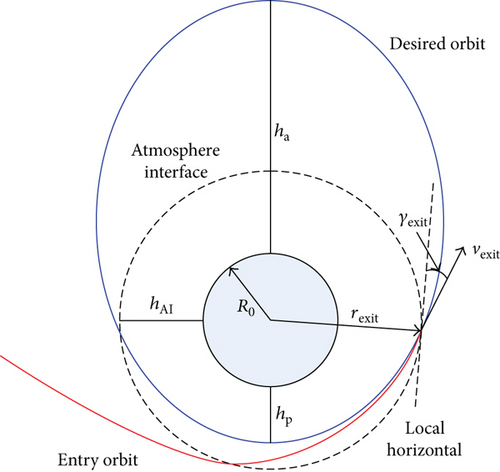
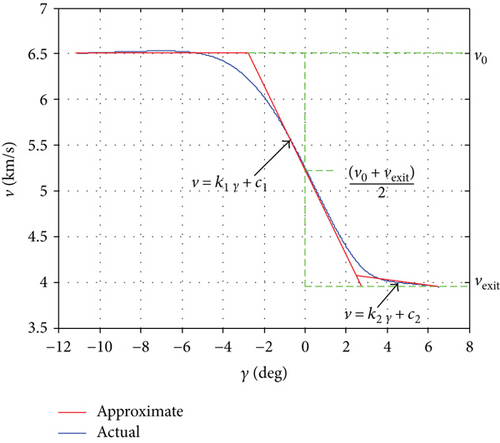
4. Aerocapture Corridor
The aerocapture corridor is an important parameter for evaluating the robustness of the guidance algorithm. Here, the corridor is defined as the span between the minimum and the maximum flight path angles for reaching the target orbit. In other words, the corridor is the boundary of the flight path angle which can ensure the probe to enter a predetermined orbit. The aerocapture corridors of the two methods are compared when the apogee height of the target orbit is about 1000 km ± 100 km, as shown in Figure 6. It can be found that the corridors of the two methods show a similar trend: as the initial entry velocity increases, the flight path angle gradually approaches 0 deg and the width of the corridor becomes narrower.
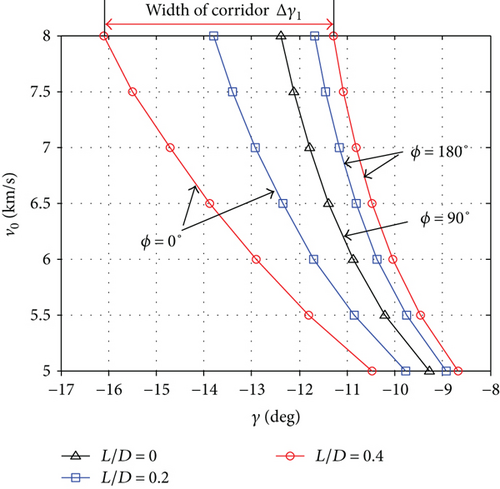
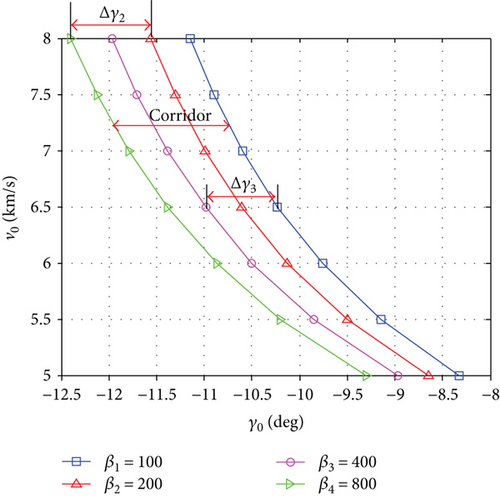
For the lift modulation mode, when ϕ = 0∘, the probe generates an upward lift, and the flight path angle reaches the lower boundary, and when ϕ = 180∘, the probe generates a downward lift, and the flight path angle reaches the upper boundary. The width of the corridor in the lift modulation is directly related to the lift-drag ratio, when L/D = 0.4, the width of the corridor is more than 1.5 deg, and the corridor is reduced to a curve when L/D = 0; although it is theoretically possible to achieve capture, because of no ballistic correction capacity, the probe cannot overcome the influence of uncertainty and error. Therefore, when using the lift modulation method, increasing the lift-drag ratio to obtain a higher design margin and robustness should be tried.
If the minimum ballistic coefficient is β1 = 100 and the maximum is β4 = 800, when v0 = 5, the width of the corridor is about 1 deg. If the minimum ballistic coefficient is β2 = 200 and the maximum is β3 = 400, the width of the corridor is only 0.3 deg, so this ratio between the minimum ballistic coefficient and maximum ballistic coefficient should be increased as far as possible.
5. Guidance Performance
5.1. Simulation Condition and Parameters
The numerical simulation is carried out for Mars exploration, which is used to verify the effectiveness of the guidance algorithm. Mars is assumed to be a uniform sphere, and its rotation effect is ignored. The gravitational constant μ is taken as 4.2828 × 104 km3/s2, Mars radius R0 is taken as 3397 km, the step size in simulation is taken as 0.1 s, and the other parameters and initial conditions are shown in Table 1 [4].
| Parameters | Nominal | Error | Distribution type |
|---|---|---|---|
| Initial velocity v0 | 6.5 km/s | ±20 m/s | Gaussian |
| Initial radius r0 | 3522 km | ±1 km | Gaussian |
| Initial FPA γ0 | −11 deg | ±0.1° | Gaussian |
| Initial longitude θ0 | 5 deg, E | ±0.05° | Gaussian |
| Initial latitude λ0 | 5 deg, N | ±0.05° | Gaussian |
| Initial heading angle ψ0 | 20 deg | ±0.05° | Gaussian |
| Ballistic coefficient βmin | 100 kg/m2 | ±10% | Gaussian |
| Ballistic coefficient βmax | 800 kg/m2 | ±10% | Gaussian |
| Initial bank angle ϕ0 | 0 deg | — | — |
| Initial mass m0 | 8000 kg | — | — |
| Perigee altitude hp | 3000 km | — | — |
| Apogee height ha | 35 km | — | — |
| Atmosphere interface hinterface | 125 km | — | — |
The validity of the atmospheric model directly affects the effectiveness of the guidance algorithm performance evaluation. Therefore, the uncertainty of the atmospheric density is taken into account in the simulation. A random error with height variation is added to the exponential atmospheric density model. The variation characteristics are shown in Figure 7.
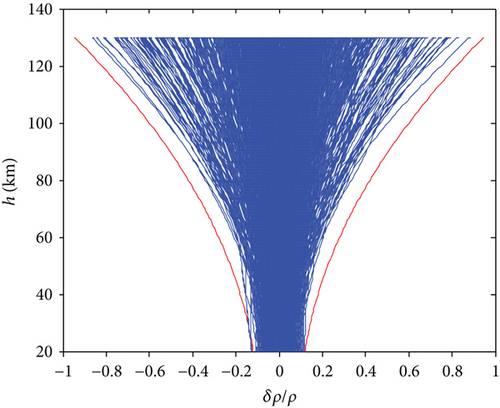
Although the model has a certain difference compared with Mars Global Reference Atmospheric Model (Mars-GRAM), it can also reflect the main characteristics of the Mars atmosphere: the atmospheric density uncertainty and height are correlated with each other; the higher the height, the greater the uncertainty [20].
5.2. APC for Lift Modulation
The performance of the analytical predictor-corrector guidance algorithm based on lift modulation is shown in Figures 8–10. Table 2 shows the distribution of perigee and apogee height under different lift-drag ratios.
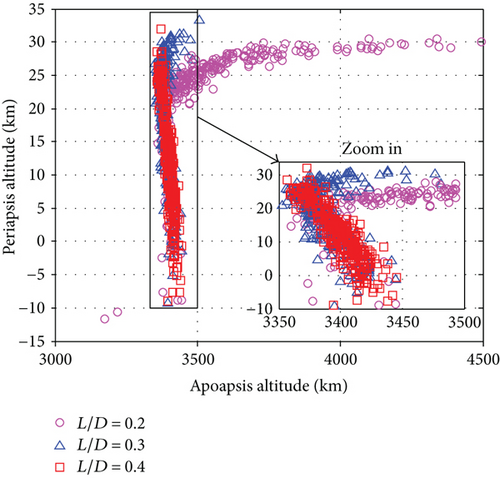
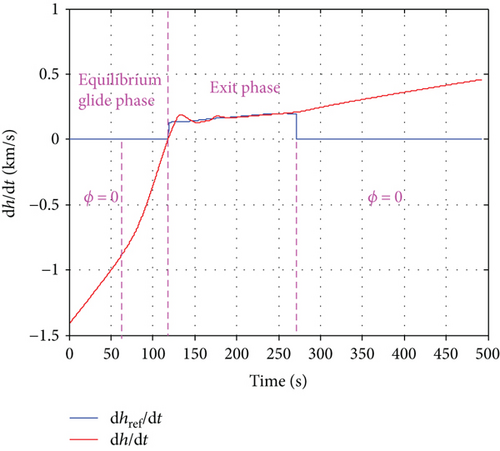
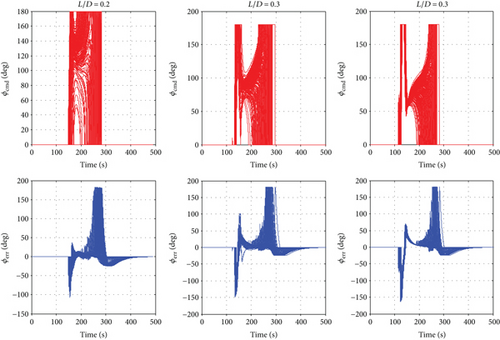
| Altitude (km) | L/D = 0.2 | L/D = 0.3 | L/D = 0.4 |
|---|---|---|---|
| hp minimum | −12 | −9 | −9 |
| hp mean | 17 | 16 | 12 |
| hp maximum | 30 | 34 | 32 |
| ha minimum | 3180 | 3350 | 3352 |
| ha mean | 3492 | 3421 | 3394 |
| ha maximum | 4494 | 3508 | 3445 |
It can be seen that the perigee and apogee heights are both deviated from the desired value by a constant, the deviation of perigee is about 15–20 km, and the deviation of apogee is about 400–500 km. By further analysis, it was found that as the height increased gradually, the ability to track the reference altitude change rate was weaker, so that the bank angle was fixed at 0 deg at the end of the flight stage, as shown in Figure 9.
With the increase of the lift-drag ratio, the distribution error of the apogee gradually decreases from 1300 km (@L/D = 0.2) to 100 km (@L/D = 0.4), and the distribution error of the perigee does not change significantly, and it is always maintained at −15 km~35 km. In addition, when the lift-drag ratio is less than 0.2, the apogee appears obvious distribution expansion phenomenon. The bank angle most of the time is in a saturated state because of less lift, the probe cannot track the reference altitude change rate effectively. With the increase of the lift-drag ratio, the time of the saturated state of the bank angle is shortened and the precision of guidance is gradually increased.
5.3. APC for Drag Modulation
Monte Carlo simulation is carried out to analyze the performance of the proposed analytical predictor-corrector guidance algorithm for the drag modulation flight control system. The simulation results are shown in Figures 11–16. Table 3 gives the distribution of perigee and apogee heights for drag modulation with different parameters.
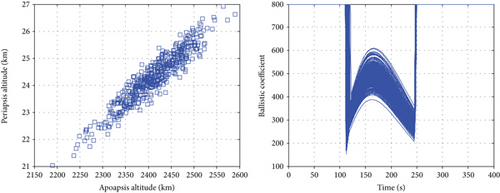
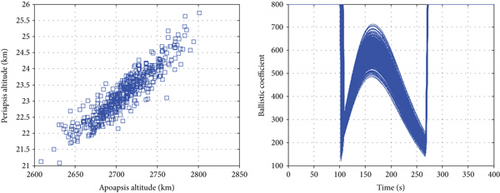
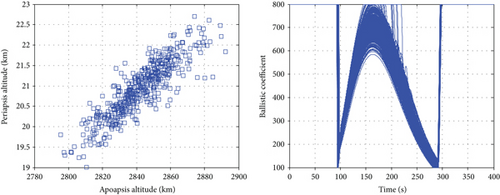


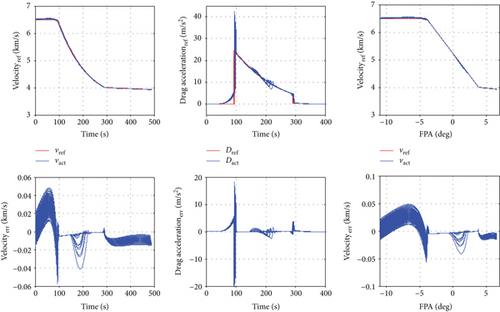
| Altitude (km) | kv1 = −26.0 | kv2 = −21.6 | kv3 = −18.6 |
|---|---|---|---|
| hp minimum | 21 | 21.1 | 19 |
| hp mean | 24.5 | 23.5 | 21 |
| hp maximum | 27 | 25.7 | 22.7 |
| ha minimum | 2191 | 2611 | 2795 |
| ha mean | 2410 | 2714 | 2844 |
| ha maximum | 2587 | 2804 | 2892 |
The simulation results show that the algorithm can effectively guide the probe to the predetermined orbit, while the apogee error is between 100 km and 400 km and the perigee error is about 5-6 km. The guidance performance is similar to the lift modulation when L/D > 0.3. With the value of kv1 increasing, the guidance performance improved gradually and the variation range of the ballistic coefficient increased gradually. The control variable β appears saturated when kv1 = −18.6, and there is a significant fluctuation of the tracking error (see Figure 16), but it does not affect the aerocapture guidance accuracy. This is because the velocity at the atmosphere interface is the main factor affecting the aerocapture accuracy. Although the tracking error of the intermediate process will affect the exit state, it can be compensated during the subsequent flight, so there is no significant influence on the final trajectory.
In addition, there is a constant deviation of the apogee which is associated with the guidance parameter. The reason is similar to the lift modulation guidance algorithm. When the probe is about to exit the atmosphere, the drag acceleration reduces to a low level resulting in the loss of control ability which leads to the guidance bias.
6. Conclusion
In this paper, the aerocapture guidance algorithms for lift modulation and drag modulation are studied around Mars exploration, and the guidance performance and corridor are analyzed, respectively. An analytical predictor-corrector guidance algorithm based on drag modulation is proposed. A piecewise linear function between velocity and flight path angle is established by appropriate approximations and assumptions, and then the state at the atmosphere interface can be predicted by an analytical method; therefore, aerocapture guidance can be realized by feedback control. The simulation results show that the guidance algorithm is accurate and robust, which can effectively overcome the influence of atmospheric density error, aerodynamic parameter error, and initial state uncertainty.
Conflicts of Interest
All the authors do not have any possible conflicts of interest.
Acknowledgments
This study was supported by the Basic Scientific Research Fund of National Defense (no. 2016110C019) and Civil Aerospace Preresearch program (no. D030106).




